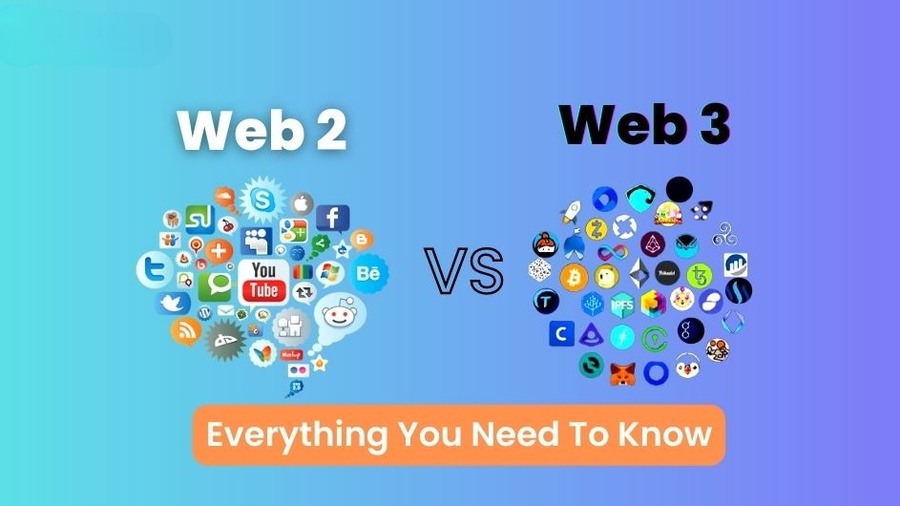In the early days of the internet, Web1 was primarily a platform for sharing information. However, with the emergence of Web2, the internet transformed into a two-way communication channel, enabling users to share and consume content interactively. Now, the latest evolution, Web3, is set to revolutionize the internet once again. In this article, we will explore the key differences between Web3 and Web2 and what these changes mean for the future of the internet.
The evolution of the internet has been a fascinating journey, from the early days of static web pages to the interactive and dynamic Web2. Now, Web3 promises to take the internet to a whole new level by introducing a decentralized, secure, and user-centric web experience. In this article, we will explore the key differences between Web3 and Web2 and what these changes mean for the future of the internet.
What is Web2?
Web2 is the current state of the internet, characterized by a two-way communication channel between users and content creators. This evolution of the internet has transformed the way we interact with information, allowing us to create, share, and consume content interactively. Web2 is powered by technologies such as social media, mobile applications, and cloud computing, which enable users to access and share information on the go.
The Emergence of Web3
Web3 is the next evolutionary step in the internet’s journey, promising to bring decentralization, security, and user control to the forefront. The emergence of Web3 is fueled by the growing concerns around centralized control and the need for a more secure and private internet experience. Web3 is powered by decentralized technologies such as blockchain, peer-to-peer networks, and smart contracts, which enable users to interact with each other and access information without the need for intermediaries.
Web3 vs. Web2: Key Differences
Let’s take a closer look at some of the key differences between Web3 and Web2.
Decentralization
Web3 is decentralized, which means that there is no central authority controlling the internet. Instead, the internet is powered by a network of computers, also known as nodes, that work together to validate and record transactions. This decentralized approach to the internet ensures that no single entity has control over the network, making it more secure and resilient.
In contrast, Web2 is centralized, with a few large corporations controlling most of the internet’s infrastructure. This centralized approach to the internet has led to growing concerns around data privacy, security, and censorship.
Blockchain Technology
Blockchain technology is at the heart of Web3, providing a secure and transparent way to record transactions. It is a distributed ledger that records transactions across multiple nodes, making it almost impossible to tamper with or manipulate.
In Web2, there is no blockchain technology, and transactions are recorded and stored on centralized servers controlled by large corporations.
Privacy and Security
Privacy and security are major concerns in Web2, with large corporations collecting and monetizing user data. Web3 addresses these concerns by providing a more secure and private internet experience. The decentralized nature of Web3 makes it harder for hackers to attack the network, and the use of encryption and blockchain technology ensures that user data is protected.
Smart Contracts
Smart contracts are self-executing contracts with the terms of the agreement between buyer and seller written into code. They are a core feature of Web3, enabling automated and trustless transactions. Smart contracts are powered by blockchain technology, which ensures that the terms of the contract are immutable and cannot be altered.
In Web2, there is no support for smart contracts, and transactions are typically mediated by third-party intermediaries, which can introduce additional costs and delays.
Interoperability
Interoperability refers to the ability of different systems and networks to communicate and exchange information seamlessly. Web3 is designed to be interoperable, enabling different blockchains and decentralized applications (dApps) to interact with each other seamlessly.
In contrast, Web2 systems are often proprietary, making it difficult for different systems and networks to communicate with each other.
User Control and Ownership
Web3 is designed to give users more control and ownership over their data and digital assets. Users have the ability to own and control their data, and they can choose to share it with others on a need-to-know basis. This user-centric approach to the internet is a major departure from the centralized and data-driven approach of Web2.
In Web2, users often have little control over their data, and large corporations control the digital assets and data of their users.
Adoption and Use Cases
Web3 is still in its early stages of development, and adoption is still relatively low compared to Web2. However, there are already several promising use cases for Web3, including decentralized finance (DeFi), non-fungible tokens (NFTs), and decentralized marketplaces.
Web2, on the other hand, has already been widely adopted and is used for a wide range of applications, including social media, e-commerce, and online gaming.
The Future of Web3
The future of Web3 is exciting, with the potential to transform the internet once again. Web3 promises to bring decentralization, security, and user control to the forefront, enabling a more secure, private, and user-centric internet experience.
As Web3 continues to evolve, we can expect to see more use cases and applications emerge, including decentralized social media, decentralized marketplaces, and more. The potential for Web3 is truly limitless, and we are only scratching the surface of what is possible.
Conclusion
In conclusion, Web3 is the next evolutionary step in the internet’s journey, promising to bring decentralization, security, and user control to the forefront. Web3 is powered by decentralized technologies such as blockchain, peer-to-peer networks, and smart contracts, which enable a more secure, private, and user-centric internet experience. While adoption is still relatively low compared to Web2, the potential for Web3 is truly limitless, and we are only scratching the surface of what is possible.

